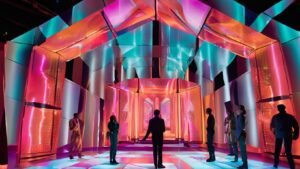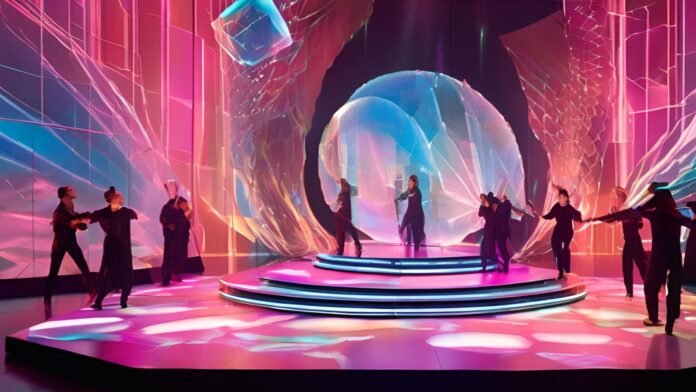Imagine this scenario: You enter a theater, and as soon as you do, you seem to fall into a different reality. The walls appear to breathe, the lights flicker like fireflies, and the stage looks like it is a living, personalized character of the story itself. Exploring the interior designing scope in theaters reveals how thoughtful design and stage direction work together to create immersive, emotionally resonant experiences that captivate audiences and bring stories to life.
This is not a fantasy, it is the potential of theater interior design. With advancements in technology and changing audience expectations, interior design is evolving from creating aesthetically pleasing environments to crafting spaces that evoke emotion and engage all the senses. Let’s explore the possibilities of how this changing interior design is impacting theater performances.
From Static to Dynamic: The Evolution of Theater Design
Honing back to the days of backdrops, static sets, and minimal designs, theater design has surely transformed to what it is now. Simply watching a show is not enough for audiences; they seek full experiences now. Furthermore, interior designers are meeting this demand by combining innovation and artistry. The interior designing scope in theaters has expanded from simple backdrops to dynamic, multi-sensory environments.

Consider, for example, the production of The Lehman Trilogy by the National Theatre. The stage was not merely a background – it was an active participant in the performance. A stage that rotated on various axes allowed the audience to have a 360-degree view, ensuring the entire performance was captivating. This is only the tip of the iceberg. Going forward, we will likely see even more novel and responsive designs that tailor themselves to the plot in real-time.
Tech Meets Creativity: The Tools of Tomorrow
The most innovative and impressive changes in the field of theater design can be attributed to new technology. Designers are using devices like holograms and augmented reality (AR) to create experiences that were only ever imagined. A more considerable example is a play performed in front of a minimalist stage where the audience wears AR glasses to increase immersion, transforming the stage into a dense forest or a lively metropolis. And let’s not overlook the sizable possibilities of holograms, where actors can project themselves to real live audiences, thus permitting actors to play with the borders of reality and fiction.
A powerful and compelling depiction of this is the production of ‘The Tempest’ by The Royal Shakespeare Company. The motion capture alongside live projection techniques that facilitated the ‘magic’ of the island was bound to impress. As the technologies become cheaper, we will probably see them used in community theaters as well. That will make the magic of immersiveness available to everyone.
Sustainability: In a Design Approach to a Global Problem
Sustainability is more than just a fad and focus of concern with the rest of the world. It is treated as an important matter even in theater design. Designers are attempting to find ways to cut down on waste production, use green materials, and construct sets that are easily transformable or buildable for different types of performances and dramas. This change is not only helpful for the globe but also encourages innovative performance solutions. Today, the interior designing scope in theaters focuses on creating immersive experiences that enhance storytelling.
For example, the Julie Ann Johnson Theatre in California boasts sustainable design through the use of reclaimed wood for their sets along with LED light fixtures. They also try to use ‘green’ designs by using live plants as set pieces. More use of these base elements can be expected in the future for greater theatrical sets and pieces while proving that art and environmentalism can indeed coexist.
Inclusivity: Designing for Everyone
The accessibility of performing arts is exemplary, and designers responsible for the interiors of the Theaters have contributed significantly when it comes to making interior spaces accessible. As an example, designers are discovering new ways to allow even those in wheelchairs to experience the bounds of theater and create performances that are sensory friendly. The evolution of theater design highlights the growing interior designing scope in theaters, blending artistry with innovation.
A good case study of such inspiring innovation is the energy friendly theatre initiative, which has greatly changed how people with autism and auditory processing disorders are taken care of in theatres. Theaters have the ability to make certain adjustments such as controls for light and sound or change how seats are arranged. Even with such simple thoughtful design, the impact on audience experience is tremendous. All these support intellectual well-being and proves that there is a need for international harmony in theater.
The Spectators: Now the Audience
Not too far into the future, we may find that the focus of the theaterab function will change focus to the users of the space, too. Let’s say a particular play could be developed in such a way that the audience could control certain aspects of the performance – lighting, music, maybe even the plot. Such concept is already tested in some experimental theatres around the globe. From static sets to interactive stages, the interior designing scope in theaters is redefining audience engagement.
For instance, a UK-based theater production company named Punchdrunk is popular for its immersive performances, where the audience moves around freely on stage, interacts with the actors, and even has an impact on the story. These interacting experiences between the performer and the audience provides features that enrich engagement, something that cannot be provided by conventional theater. With the improvement of technology, there will probably be many more theaters using this technique that changes the role of spectators from passive viewers to active participants.
Real-World Examples: Pushing the Boundaries
Let’s take a closer look at some real-world examples of innovative theater design that are shaping the future:
- The Shed, New York City
This prestigious cultural center is equipped with an outer shell that allows it to be reconfigured to different layouts for different performances. Because of these features, there are endless possibilities for creativity in the space, from performing intimate plays to large-scale productions. - The Elbphilharmonie, Hamburg
Although Elbphilharmonie was designed as a concert hall, there is much to be learned from its design for theater construction, especially the wave-like design of the ceiling that also has immersive acoustics. The space in general has an energetic feel which engages the audience into the music or in a case of drama, the narrative. - The Floating Piers, Lake Iseo (Art Installation)
While Floating Piers is not a conventional theatre, Christo and Jeanne-Claude’s installation acts as one in demonstrating the possibilities of interaction that can be done with space. Consider a more extreme interpretation to that idea: a theatre where the stage moves towards the audience and performers physically dissolve the border between the stage and spectators.
The Future: What’s Next for Theater Design?
So, what new developments can be expected regarding the interior of the theatre? Let’s examine these suggestions:
- Virtual Reality (VR) Theaters
What if one could watch a play from their bedroom while comfortably dressed in pajamas? With a VR headset, one could feel as if they are sitting in the front row, or even standing on stage beside the actors. A tremendous advance in the world of theater could be achieved with VR. Theatre could become available for people all over the globe. - AI-Driven Design
Designers could potentially come up with sets that change in real time with the action happening on stage with the help of artificial intelligence. Consider a scenario were an AI system is able to analyze the movements of the actors in real time and change the lightning, set, and sound based on the context and location. - Biophilic Design
Developing the audience chamber in a structure can be more relaxing and engrossing by introducing such natural features as plants, water bodies, lighting, etc. This method boosts the impression of the audience and also helps in conservation.
Read more:
How the STEM Education System Works in the United States
Conclusion: The Role of Design in Storytelling
Interior design of the theater is no longer confined to being the stage set for the performance. As we move ahead, it is evident that the set design should enhance multi-sensory engagement and elicit feelings and immersion to take the audience into different worlds. There are no bounds to innovation, as every aspect of modern technology, design, and sustainability can be integrated within a performance space. The interior designing scope in theaters now includes adaptable spaces that respond to the performance in real time.
It is high time we began to focus on the built space of the auditorium and consider how these structures work around the story being told. Next time you walk into a theater, try to observe the details and think how the design helps to narrate the set story, connects you to the action on stage, and most importantly how it makes you feel. Because it is not just the action on stage that matters – it is what happens in the entirety of the theatre and how all those elements work together.
Now it is time to ask ourselves, how does the future scope of designing a theatre building look like and what experience boundaries can be conquered in terms of storytelling through the design crafted within the auditorium.


